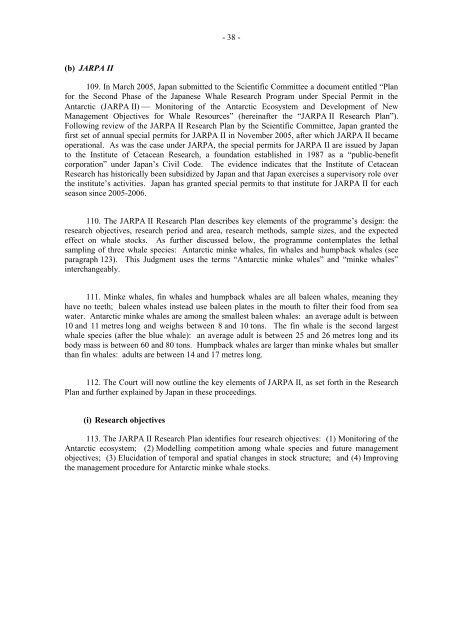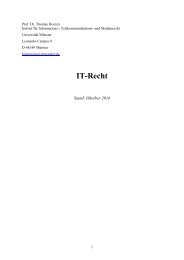3d4yVkKMl
3d4yVkKMl
3d4yVkKMl
Create successful ePaper yourself
Turn your PDF publications into a flip-book with our unique Google optimized e-Paper software.
- 38 -<br />
(b) JARPA II<br />
109. In March 2005, Japan submitted to the Scientific Committee a document entitled “Plan<br />
for the Second Phase of the Japanese Whale Research Program under Special Permit in the<br />
Antarctic (JARPA II) Monitoring of the Antarctic Ecosystem and Development of New<br />
Management Objectives for Whale Resources” (hereinafter the “JARPA II Research Plan”).<br />
Following review of the JARPA II Research Plan by the Scientific Committee, Japan granted the<br />
first set of annual special permits for JARPA II in November 2005, after which JARPA II became<br />
operational. As was the case under JARPA, the special permits for JARPA II are issued by Japan<br />
to the Institute of Cetacean Research, a foundation established in 1987 as a “public-benefit<br />
corporation” under Japan’s Civil Code. The evidence indicates that the Institute of Cetacean<br />
Research has historically been subsidized by Japan and that Japan exercises a supervisory role over<br />
the institute’s activities. Japan has granted special permits to that institute for JARPA II for each<br />
season since 2005-2006.<br />
110. The JARPA II Research Plan describes key elements of the programme’s design: the<br />
research objectives, research period and area, research methods, sample sizes, and the expected<br />
effect on whale stocks. As further discussed below, the programme contemplates the lethal<br />
sampling of three whale species: Antarctic minke whales, fin whales and humpback whales (see<br />
paragraph 123). This Judgment uses the terms “Antarctic minke whales” and “minke whales”<br />
interchangeably.<br />
111. Minke whales, fin whales and humpback whales are all baleen whales, meaning they<br />
have no teeth; baleen whales instead use baleen plates in the mouth to filter their food from sea<br />
water. Antarctic minke whales are among the smallest baleen whales: an average adult is between<br />
10 and 11 metres long and weighs between 8 and 10 tons. The fin whale is the second largest<br />
whale species (after the blue whale): an average adult is between 25 and 26 metres long and its<br />
body mass is between 60 and 80 tons. Humpback whales are larger than minke whales but smaller<br />
than fin whales: adults are between 14 and 17 metres long.<br />
112. The Court will now outline the key elements of JARPA II, as set forth in the Research<br />
Plan and further explained by Japan in these proceedings.<br />
(i) Research objectives<br />
113. The JARPA II Research Plan identifies four research objectives: (1) Monitoring of the<br />
Antarctic ecosystem; (2) Modelling competition among whale species and future management<br />
objectives; (3) Elucidation of temporal and spatial changes in stock structure; and (4) Improving<br />
the management procedure for Antarctic minke whale stocks.



